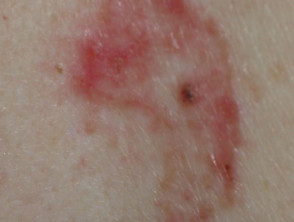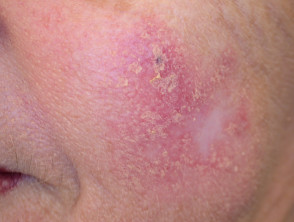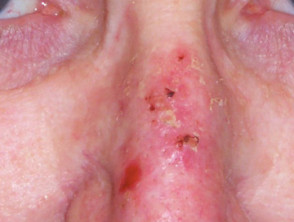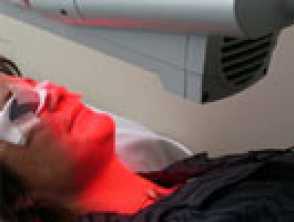Introduction
Photodynamic therapy (PDT) is a treatment used mainly for superficial types of skin cancer. PDT is effective in treating actinic keratoses, in situ squamous cell carcinoma (Bowen disease), and superficial basal cell carcinomas. It may also be used for treatment of small, thin, low-risk nodular basal cell carcinomas outside of the head and neck area.
Skin lesions suitable for photodynamic therapy
PDT is also sometimes used off-label for facial rejuvenation and to treat mild to moderate acne, and a variety of skin infections including wound infections, onychomycosis, viral warts, and cutaneous leishmaniasis. Several other conditions have also been studied and may respond to PDT such as psoriasis, mycosis fungoides, and extramammary Paget disease.
What is PDT and how does it work?
PDT utilises photosensitising agents, oxygen and light, to create a photochemical reaction that selectively destroys cancer cells. Photosensitising agents are drugs that are administered into the body through topical, oral or intravenous methods. In the body, they concentrate in cancer cells and only become active when light of a certain wavelength is directed onto the area where the cancer is. The photodynamic reaction between the photosensitising agent, light and oxygen produces reactive oxygen species (singlet oxygen, hydroxyl radicals, and superoxides) which interact with cellular structures and cause cell death.
Photosensitising agents
Methyl aminolevulinic acid cream
- Registered for use in NZ for the treatment of actinic keratoses and superficial basal cell carcinoma
- Used with red light or daylight
- Cutaneous photosensitivity resolves within 24 hours after application
Aminolevulinic acid hydrochloride topical solution
- Registered in the USA for the treatment of actinic keratoses
- Used with blue light
BF-200 ALA gel
- Registered in the USA for the treatment of actinic keratoses
- Nanoemulsion formulation containing 10% aminolaevulinic acid hydrochloride
- Used with red light, BF-RhodoLED
Porfimer sodium
- Administered intravenously
- Causes generalised cutaneous photosensitivity that can last for months
Benzoporphyrin derivative monoacid ring A
- Second-generation photosensitisers undergoing evaluation
Tin ethyl etiopurpurinLutetium texaphyrin
Light sources
Light sources used in PDT include laser, nonlaser, and ambient daylight.
Laser light has the advantages of being:
- Monochromatic (exactly one colour/wavelength that corresponds with the peak absorption of the photosensitising agent)
- Coherent (able to focus lightwaves to specific site)
- Intense (high irradiance allowing for shorter treatment times).
Laser light is suitable for small skin lesions whilst nonlaser light is better for the treatment of large skin lesions as the field of illumination is larger.
Nonlaser light that emits polychromatic light is also suitable when using different photosensitisers with different absorption maxima. They are considerably cheaper than laser sources.
Natural daylight is used successfully as a light source for the treatment of actinic keratoses. It has the advantage of being readily available and free, but 2 hours exposure is needed. In some locations and seasons, it is not reliable or of sufficient intensity (see methyl aminolevulinic photodynamic therapy).
Ambulatory devices containing the photosensitiser and a battery operated LED source have been developed for single, small, premalignant, non-melanoma skin cancers.
What is PDT used for?
PDT is currently being used or investigated as a treatment for the following skin conditions:
- Actinic keratoses on the face and scalp
- Acne
- Basal cell carcinomas
- Cutaneous leishmaniasis
- Intraepidermal squamous carcinoma (squamous cell carcinoma in situ, Bowen disease)
- Squamous cell carcinoma
- Mycosis fungoides (cutaneous T-cell lymphoma)
- Kaposi sarcoma
- Onychomycosis
- Psoriasis
- Viral warts.
How is PDT given?
Stage 1
- The skin may be gently scraped (curettage) or needled beforehand to increase the amount of the drug absorbed.
- Photosensitising drug is applied to the lesion.
- Waiting for a period of time (usually between 3 and 6 hours) allows the drug to concentrate in the cancer cells.
- Urea or salicylic acid creams may be used for 7 days the help descale hyperkeratotic lesions to help photosensitiser penetration
Stage 2
- Laser light or nonlaser light is shone directly on to the treated area.
- Treatment usually last between 5 and 45 minutes with an artificial source, and 2 hours with daylight.
- The treated area is covered with a dressing which will also protect the area from further light exposure.
- Depending on the type of lesion being treated and the photosensitising chemical used, a 2nd cycle of treatment may be given 7–10 days later.
Stage 3
- A sunburn reaction occurs, which usually heals within 4 to 8 weeks.
Recent evidence suggests that topical PDT may be more effective if the patient is treated with high dose oral vitamin D for 7 days before the treatment is administered.
What are the possible side effects of PDT?
Side effects from PDT are due to the treated area being sensitive to light. The photosensitivity usually lasts about 24 hours (depending on the specific agent). Side effects may include:
- Burning/stinging sensation
- Swelling and redness
- Crusting
- Itchiness
- Peeling and blisters
- Skin infections.
The treated area should be protected from light exposure using a dressing. A local anaesthetic such as lignocaine (lidocaine) spray may be applied to the treatment area before or during Stage 2 of the procedure to help relieve pain.
The treated skin lesion may blister and ulcerate as the cancer cells die off. This may take several weeks to heal. Scarring is generally minimal (but can be moderate). Loss of pigmentation may occur sometimes and can be permanent.
Although photosensitising drugs concentrate in cancer cells, they can also make healthy cells more sensitive to light. This is not a problem when photosensitising creams are used as they are localised to the treatment site. It is more of a problem when photosensitising drugs are given by mouth or injected intravenously. These patients may find all parts of their body sensitive to light and should take precautions to protect themselves from light for the necessary period of time (may be days or weeks depending on the photosensitising drug used).



